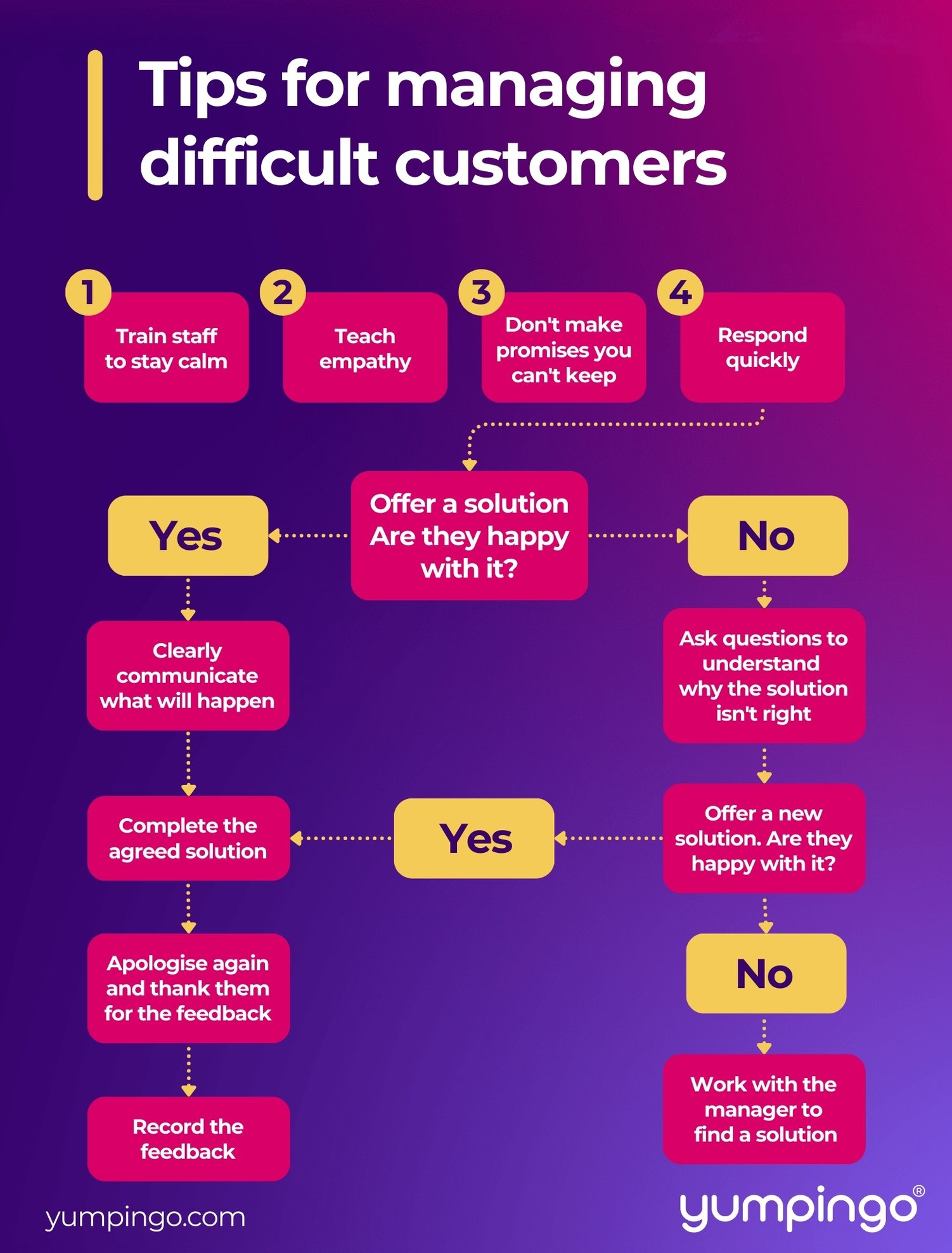How to deal with difficult customers [+ examples]

In customer facing roles, particularly in hospitality, dealing with difficult customers is inevitable, even if you’re known for consistently delivering high quality service. Whether a customer has an angry outburst, is rude or even indecisive it can cause service levels to falter, but it’s important that these situations are dealt with head on. After all, 80% of customers will forgive a bad experience if they view the service team as ‘very good’.
In this article we’ll explore the different types of difficult customers, example scenarios and how to handle them so you can best navigate those difficult conversations with customers.
Different Types of Difficult Customers
Having an understanding of the different types of difficult customers can help you identify them and quickly resolve any issues. Here are a few difficult customer examples:
The customer who continuously complains
This customer will express any negative feelings they have about your service or products, whether this is through your website, social media or frequently stopping staff to complain.
Example problem:
Customers are frequently complaining about your chips always being cold.
How to handle this situation:
Show that you empathize with the customer and ask questions to indicate that you want to take the time to understand their root problem and find a solution. A lot of the time the customer just wants to vent and feel like their problems are being taken seriously.
You should also reinforce to your staff that these complaints aren’t personal. If the restaurant is getting the same complaints on a regular basis, solutions should be put in place to prevent them from occurring again.
The customer that’s difficult to please
No matter the level of customer service delivered, this type of customer will find fault with everything. They usually argue back and forth on their opinions and finding a solution.
Example problem:
A customer may complain about there being no meat in their vegetarian dish.
How to handle this situation:
Ask the customer what they’re looking for and the solution they would like to see. Complete it if it’s actionable, but if it isn’t you should try and find a fair solution.
Collecting data surrounding customer experience and creating smart actions will also help you properly navigate difficult situations, as staff will be trained to deal with and resolve issues effectively.
The customer that might churn
This type of customer is close to leaving and going to a competitor. This usually occurs when they’ve had multiple bad experiences that have been raised to your restaurant but not dealt with to a satisfactory level.
Example problem:
The customer has complained multiple times about service being slow and that their food arrived before their drinks. Since making the complaint no solution has been found and the manager hasn’t visited their table to help resolve the issue.
How to handle this situation:
Empathize and clearly communicate with the customer what you are doing to rectify the situation. You can get the management team involved to resolve the issue with discounts, vouchers or upgrades.
The indecisive customer
This customer may not know how they want you to rectify their issue or how to describe their dissatisfaction. This may be shown through vague communication.
Example problem:
The customer is so frustrated by the poor service they have experienced that they’re struggling to articulate the issues they’re facing.
How to handle this situation:
Ask questions that clarify the situation so that you can provide an accurate resolution that the customer will be happy with.
The customer that has unrealistic expectations
Customers with unrealistic expectations often want their bill to be cheaper and are looking for restaurants to deliver something they can’t.
Example problem:
The customer has made a complaint about the quality of the food and would like a discount on the bill. However, they have eaten all of their food.
How to handle this situation:
Identify their issues or concerns and address them as best as possible. If these aren’t possible, it’s important to set boundaries to prevent unrealistic expectations forming.
The customer that refuses to accept that they’ve made a mistake
We all know that at some point we haven’t been able to admit when we’re wrong. This can often be the case for customers in restaurants.
Example problem:
A customer may be adamant that they booked a table for today but they actually booked it for tomorrow. The customer may stress they are right and your system is wrong, causing an issue where one isn’t needed.
How to handle this situation:
This situation requires patience, calmness and empathy. If there are no tables available, it’s best to apologize to the customer and not make any promises you can’t keep.
For example, you could say something like ‘Apologies, your booking is on our system for tomorrow and we’re at capacity. If you come back in an hour we may have a table available for you, but we can’t make any promises’.
6 tips for managing difficult customers

Here are some of the best ways to deal with difficult customers:
1. Train your staff to stay calm
When a customer is being rude or yells, staying calm can help diffuse the situation or prevent it from escalating further. It’s unlikely that the customer is angry with you and is instead likely frustrated by the quality of food or service provided by the restaurant as a whole.
Training staff to stay calm and take the time to breathe can help reduce stress and anger, helping servers navigate an uncomfortable situation professionally. Don’t forget to let your team know that if they’re feeling overwhelmed they can ask for help and walk away (professionally of course).
2. Teach empathy
Sometimes all a customer wants is to feel understood. Displaying empathy will show the customer that you are taking their concerns and complaints seriously and intend to find a solution.
3. Ensure staff don’t make any promises they can’t keep
While it’s easy to make a promise to keep a customer happy, you really should avoid promising something you can’t deliver. People will expect you to follow through and when you don’t meet their expectations it’ll only intensify the situation further.
4. Provide quick responses and solutions
Engaging with the customer promptly can make them feel valued and that their complaint is being dealt with properly. In fact, a CX Trends Report found that 76% of shoppers expect to engage with someone immediately after they’ve reached out to a business for help.
5. Teach servers how to maintain a positive relationship
Maintaining a positive relationship with your customers can show them that you respect and appreciate their feedback. It could even encourage them to return in the future. By asking the customer if they have any other concerns it shows that you were listening and value their feedback.
6. Record feedback
Recording customer feedback is important as management can use it to identify any recurring issues. At Yumpingo, we can help managers pinpoint any continual issues with food, helping them find solutions and reduce how often they need to deal with customer complaints.
Examples of dealing with difficult customers
The customer asks to speak to the manager
When a customer asks to speak to the manager, they may appear angry or frustrated or even resort to shouting. This situation can be uncomfortable but you can handle this professionally.
Handling the situation:
Before handing the situation over to the manager you should talk to the customer calmly and offer a genuine apology to see if you can help resolve the issue first. If the customer doesn’t calm down and is still insistent on speaking to the manager you should work with them to find a solution.
The customer requests a refund
The customer didn’t enjoy their meal and found that it didn’t match their expectations based on the description on the menu.
Handling the situation:
You can handle this situation by listening to the customer, apologizing and offering a discount where necessary.
The customer leaves a negative review
Let's be honest, no one likes it when a customer leaves a bad review, but it’s important to remember that it’s been left for a reason.
Handling the situation:
If the review is lacking information, politely request more information through a communication channel that best suits them. This will help you understand the context behind their complaint so that you can find a solution.
If you’re constantly getting complaints about certain aspects of your service, it may be beneficial to find a simplified way to maximize guest and team engagement through using a trustworthy customer experience management system, like Yumpingo.
- Improve customer retention - We can help you reduce unhappy guests by 34% by managing the root causes of dissatisfaction.
- Increase customer acquisition - We can help you boost word of mouth customer advocacy and deliver 14% more happy guests.
- Improve menu margins - We can help you grow guest happiness and increase margins by 2.5%.
To learn more about handling difficult customers and how you can maximize guest and staff engagement, request a demo today.
Share this:
Subscribe to our Newsletter
You May Also Like
These Related Stories

Are you looking to launch a new restaurant or concept? Yumpingo can help!

Empower your restaurant marketing: break the apology habit
